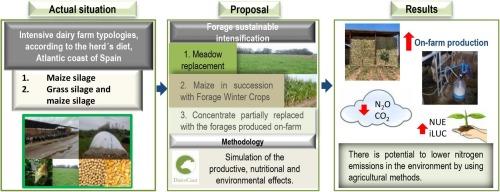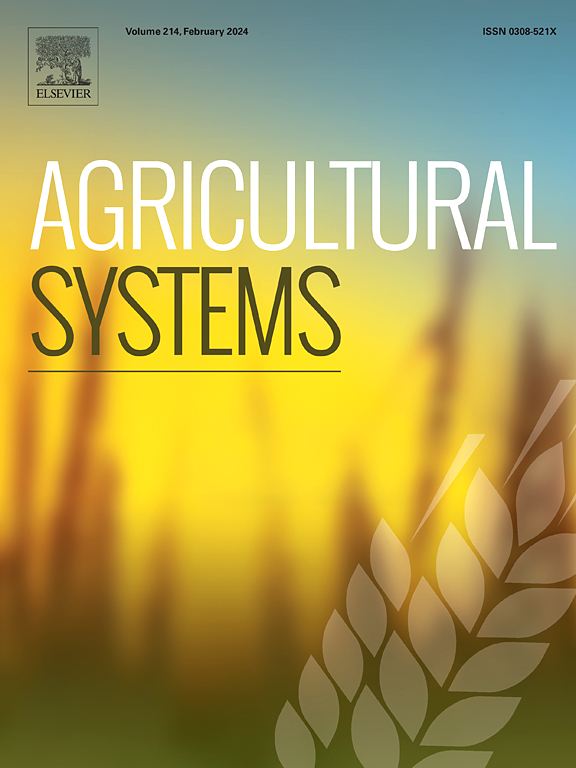温带大西洋气候下奶牛场的可持续集约化;对生产、营养和环境方面的影响
IF 6.1
1区 农林科学
Q1 AGRICULTURE, MULTIDISCIPLINARY
引用次数: 0
摘要
背景动物饮食、牧场管理和饲料生产是奶牛场实现效率最大化和环境影响最小化需要考虑的因素。在气候变化的威胁下,可持续的饲草集约化可能是维持食品安全和盈利能力,同时保护环境的一个可行解决方案。该方法基于饲草集约化,将草地区域转化为一年生饲草作物,用牧场生产的青贮饲料替代奶牛日粮中最多 30% 的精料摄入量。在考虑到牧场面积和用途、牲畜数量、日粮、产奶量和泥浆管理的情况下,采用了代表两种集约化系统中平均牧场的模型牧场。使用模拟模型 DairyCant 对平均牧场进行模拟,模拟牧场目前的管理状况(基线)、Zea mays L. 与各种冬季饲料作物的交替情况(7 种情况)、牧群中奶牛数量的变化(7 种情况)以及牧群日粮中精料的部分替代情况(另外 14 种情况),结果每个集约型奶牛场系统都进行了 28 次模拟。结果与结论通过饲草集约化,增加了饲草产量,从而减少了饲料进口,饲料生产也因此得到调整,牧场主的收益率也得以提高。此外,氮(N)盈余和氮足迹总量等环境因素也有所减少,这表明有可能减少农场温室气体排放和氮损失。从生产、营养和环境角度来看,Z. mays L. 与 Trifolium incarnatum 相继的方案最有意义。同时,减少精料摄入量还能提高牧场的经济可持续性。要切实实施本文所述的饲草管理,必须考虑到牧场主的能力和意愿以及潜在的支持政策。本文章由计算机程序翻译,如有差异,请以英文原文为准。

Sustainable intensification of dairy farms in temperate Atlantic climate; effects on productive, nutritional and environmental aspects
CONTEXT
Animal diet, farm management, and feed production are factors that need to be considered in order to maximize the efficiency and minimize the environmental impacts of dairy farms. Sustainable forage intensification could be one possible solution in order to maintain food security and profitability and at the same time respect the environment under the threat of climate change.
OBJECTIVE
This work simulates the productive, nutritional, and environmental effects of cattle dairy farms in wet temperate regions of North Spain, under sustainable intensification. This approach was based on forage intensification by converting grassland areas to annual forage crops and replacing the concentrate intake in dairy cows' diet by up to 30 %, with silage from the forages produced on-farm.
METHODS
Two intensive dairy systems were used, identified according to the herd's diet composition. A model farm that represents an average farm in each of the two characteristic intensive systems was employed, taking into consideration field area and use, number of animals, diet, milk yield and slurry management. The simulation model DairyCant was used to run simulations of the average farms under present management (baseline) and under scenarios over succession of Zea mays L. to various winter forage crops (7 scenarios), with variation of the number of dairy cows in the herd (7 scenarios) and under partial replacement of concentrate in the herd's diet (14 more scenarios), resulting to 28 simulations for each intensive dairy system.
RESULTS AND CONCLUSIONS
Using forage intensification, the production of forages was increased and as a consequence, feed imports are reduced, thus feed production is relocated and farmers' profitability could be increased. Besides, the environmental factors, such as the nitrogen (N) surplus and the total N footprint were decreased, indicating that would have the potential to reduce farm GHG emissions and nitrogen losses. The scenarios involving Z. mays L. succession to Trifolium incarnatum were the most interesting, from a productive, nutritional and environmental point of view.
SIGNIFICANCE
Replacing grassland with annual forage crops and reducing concentrate intake of dairy cows could result to increase of the nitrogen use efficiency, which means less nitrogen excreted to the environment. At the same time, the reduction of the concentrate provides the potential to improve the economic sustainability of the farms. To establish the realistic implementation of the forage management described here, farmers' abilities and willingness, together with potential supportive policies, must be taken into account.
求助全文
通过发布文献求助,成功后即可免费获取论文全文。
去求助
来源期刊

Agricultural Systems
农林科学-农业综合
CiteScore
13.30
自引率
7.60%
发文量
174
审稿时长
30 days
期刊介绍:
Agricultural Systems is an international journal that deals with interactions - among the components of agricultural systems, among hierarchical levels of agricultural systems, between agricultural and other land use systems, and between agricultural systems and their natural, social and economic environments.
The scope includes the development and application of systems analysis methodologies in the following areas:
Systems approaches in the sustainable intensification of agriculture; pathways for sustainable intensification; crop-livestock integration; farm-level resource allocation; quantification of benefits and trade-offs at farm to landscape levels; integrative, participatory and dynamic modelling approaches for qualitative and quantitative assessments of agricultural systems and decision making;
The interactions between agricultural and non-agricultural landscapes; the multiple services of agricultural systems; food security and the environment;
Global change and adaptation science; transformational adaptations as driven by changes in climate, policy, values and attitudes influencing the design of farming systems;
Development and application of farming systems design tools and methods for impact, scenario and case study analysis; managing the complexities of dynamic agricultural systems; innovation systems and multi stakeholder arrangements that support or promote change and (or) inform policy decisions.
 求助内容:
求助内容: 应助结果提醒方式:
应助结果提醒方式:


